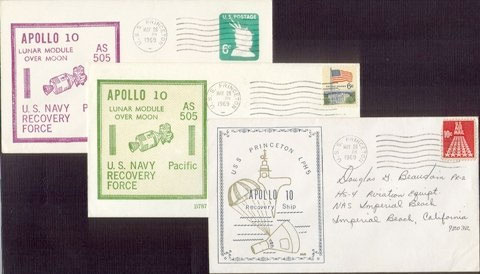Space Cover #6, Apollo 10 RecoveryForty years ago this week Apollo 10, the "dress-rehearsal" for the first moon landing, splashed down in the Pacific and was recovered by the aircraft carrier USS Princeton. This week's cover(s) of the week celebrate that splashdown and give us a chance to explain the different types of recovery ship covers available.
These covers were all postmarked onboard the prime recovery ship, the USS Princeton, on May 26, 1969, the day of the Apollo 10 recovery. There were a number of other ships standing by to recover Apollo 10 (known as secondary recovery ships) that also postmarked covers that day, but we will just look at the prime ship today.
The far left cover (with the magenta rubber-stamped cachet) is known as a Navy Cachet or as a Beck Rubber Stamped Cachet (Beck RSC). Morris Beck designed a unique rubber stamp for each flight, and often different rubber stamps for the Atlantic and Pacific recovery fleets. He sent these rubber stamps out to the ships, and the postal clerks onboard the ships used the rubber stamps to cachet the thousands of covers sent in for postmarking on recovery day. Since this cachet was applied at the postal facility, it is often considered an official postal marking in some circles (this should fuel some discussion! lol).
The middle cover (green printed cachet) is known as a Beck Printed Cachet. Mr. Beck also printed up a few hundred cacheted covers using the same design as his rubber stamp. These can be most easily identified by the "BXXX" number underneath the cachet. Collecting of Beck's cachets (he did many more than just the recoveries too) is a collecting niche all of its own. For more info on the Beck cachets, please refer to Owen Murray's excellent website.
The upper crust of prime recovery ship covers are the Captain's Covers. Often the ship's captain had a unique cachet printed up for his use (in some cases) or the crew's use (in other cases). The Apollo 10 USS Princeton Captain's Cover is the far right cover in our three. The numbers of Captain's Covers produced for different flights are unknown. Some are plentiful (like Gemini 4 USS Wasp) while others are very hard to come by (like the Apollo 10 Princeton).












